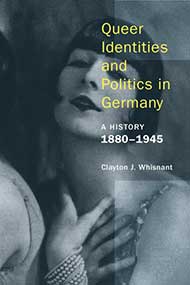QUEER IDENTITIES AND POLITICS IN GERMANY
A History
1880-1945
By
Clayton J. Whisnant
400 pages
Paperback, $40.00 ISBN: 9781939594099
Hardcover, $95.00 ISBN: 9781939594082
E-book, $19.99 ISBN: 9781939594105
ORDER HERE
- 30% web discount (use discount code HPP30 in shopping cart)
Menu
LIST OF ABBREVIATIONS
ACKNOWLEDGMENTS

Why Study Queer German History?
Queer Identities and Politics in Germany: A History, 1880–1945 offers a useful and readable account of the history of homosexuality in Germany between the end of the nineteenth century, when the homosexual movement formed, and 1945, when the Allies finally defeated the Nazi state. The conclusion looks forward to the present, suggesting the ways that the long history of LGBTQ life and politics in Germany continued to be felt after 1945: in the gay scenes that reemerged after the war, in the various political movements that eventually reappeared, in the scientific theories of sexuality that continued to evolve, and in the different sexual identities that LGBTQ individuals have adopted. Queer Identities and Politics in Germany not only looks at the individuals, events, and movements of the era, but also briefly surveys some of the scholarly debates that have defined the historical literature. This book offers opportunities to consider important issues still facing lesbians, gay men, bisexuals, transgender individuals, and others within the larger queer community—issues of identity, language, community building, and political strategizing.

These scandals created publicity for the homosexual movement, but not the kind that the movement wanted. In fact, the Eulenburg scandal produced a serious crisis for Hirschfeld’s WhK and created a political atmosphere in which the government seriously considered sharpening the law against homosexuality instead of repealing it. To get through this difficult period, homosexual activists tried to build alliances with other movements: feminism, Freudianism, and youth organizations. Not all these alliances would prove productive, but the effort to build them was a critical step in the maturation of the homosexual movement.
As men and women began to develop identities in which deep physical or erotic attachments to members of the same sex played an important role, they found they had much available in their society and culture to work with. This chapter focuses mostly on the efforts of recent historians to broaden our understanding of science’s effects and in other ways expand the conversation to include additional factors. It considers the importance of the classical heritage in some detail, but it also examines the significance of the Romantic tradition, ideas about “modernity,” and the homosexual press for the articulation of homosexual identity. Special attention is given to the poems of Stefan George, the photographs of Wilhelm von Gloeden, the film Girls in Uniform, and novels written by Klaus Mann, John Henry Mackay, and Anna Elisabet Weirauch.
There has, however, been a tendency to exaggerate Weimar Germany’s tolerance of homosexuality. This chapter offers an important corrective. Conservative voices warning against the dangers of modern life were plentiful. Politically, parties such as the Catholic Center Party and the nationalist German National People’s Party quickly recovered, while fringe parties like the newly organized Nazi Party lurked ominously in the background. The WhK, consequently, had its work cut out for it. Magnus Hirschfeld carried on with his business of spreading public enlightenment about sexuality and fighting against Paragraph 175. He was joined by both old friends and new supporters, but he also encountered many new challenges: professional adversaries, rivals for control of the growing homosexual movement, and, most dangerously, nationalist opponents of his sex reform agenda who would have been happy to see him dead.
This chapter considers the motives behind these Nazi policies toward homosexuality. Furthermore, it examines the fate of those scientific and psychiatric institutions that had devoted so much time to homosexuality since the mid-nineteenth century. In the process, this chapter also probes the thorny issue of whether scientific research into homosexuality opened the door for Nazi persecution. It concludes with some reflection on the sexual opportunities created by the Second World War.
Gay and Lesbian Life after 1945
In the 1960s much began to change. Both countries removed their laws against consensual adult male homosexuality. The sexual revolution generated a new openness toward sexual relationships that did not ft the norm. By the 1980s homosexual activists in both East Germany and West Germany began to memorialize homosexual victims of Nazi persecution, suggesting that this era of brutality was being reclaimed and refashioned into an emblem of survival and strength. The unification of Germany in 1990 and the creation of the European Union shortly afterward laid the groundwork for achieving new rights and protections for LGBTQ people in Germany.

